Paramount outcry against state-sponsored temple destruction
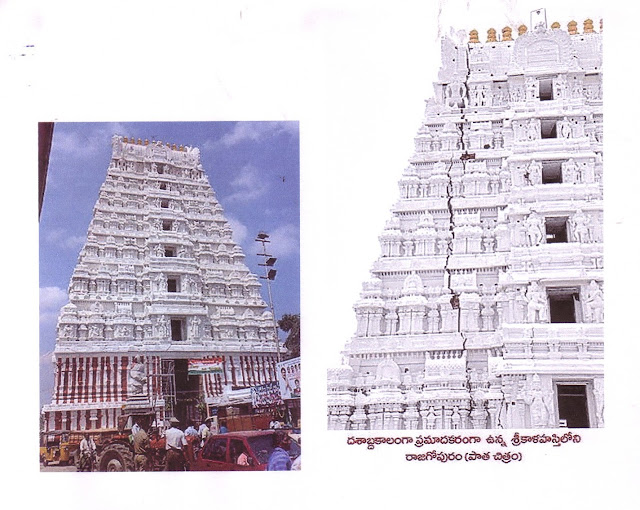
The beautiful and majestic Rajagopuram                     The cracks on the Rajagopuram above Tower at Kalahasti   photographed two days prior to the collapse
There is a paramount public cry today for the preservation of India’s ancient cultural heritage. The Rajagopuram (is the mighty tower in front of the gateway to the temple) of Sri Kalahasti Temple at Kalahasti Town in ANDHRA PRADESH collapsed at 8:30 PM on May 26, 2010. This glorious tower is more than 500 years old and measures 135 meters in height. The main temple structure dedicated to Hindu God Shiva, has not been affected by the sudden collapse of the entrance tower (Rajagopuram). Fortunately there were no human casualties this time.
The debris of the collapsed portions of the Rajagopuram
The collapse of the Rajagopuram created panic among pilgrims, who blamed the negligence of officials and temple board members for the mishap. While the cracks became prominent in the past four days, it is learnt that narrow crevices had started appearing some years ago. According to reliable local sources, vibrations from bore-well digging in the temple vicinity directly contributed to the collapse. An eminent observer has said: “The digging has been going on in a relentless manner (with the full knowledge of an anti-Hindu and truly evangelical Government like that of YSR!) up to a depth of 500-600 ftâ€.
The Rajagopuram had been in trouble for over a decade with stones and clay falling off from the structure from time to time. A few years ago, a tourist was killed when a stone fell on him. Though civil society groups had complained to the temple authorities during the last few years about the front tower’s deteriorating condition, the latter did nothing other than carrying out some minor repairs sporadically from moment to moment.
The Rajagopuram, with seven storeys, was built in 1516 by the great Emperor Krishna Devaraya who ruled from 1509 to 1529. This Raja Gopuram stood to the right side of the main temple and has been a living testimony to the grandeur of the Vijayanagara Empire for 5 centuries.

2009 saw the 500th anniversary of the accession of the great monarch Krishnadevaraya to the throne of the Vijayanagar Empire in 1509. To mark this great historic occasion, the Andhra Pradesh Government had raised a commemorative statue in front of the Rajagopuram in Sri Kalahasti temple in 2009. I have presented above a photograph of this statue. Behind the statue we can clearly see the debris of the collapsed Rajagopuram.
Contextually and historically it will be very relevant to refer to the recent discovery of an exquisitely beautiful small metal Portrait sculpture of Krishnadeva Raya found at Varadaraja Swami Temple at Kancheepuram. I am presenting below a photograph of this statue of Krishnadeva Raya.

This exquisite metal sculpture of Krishnadeva Raya, a few inches tall, is found on a step leading to the Goddess Perundevi shrine. It was noticed by R. Nagaswamy, former Director of the Tamil Nadu Archaeology Department. Next to Krishnadeva Raya is a metal portrait of one of his two queens.
T.S.Subramaniam has described the statue thus: “The Krishnadeva Raya portrait shows him standing with folded hands, a sword tucked behind his left hand; he has a dagger too. He is wearing a tall, conical crown studded with diamonds and rubies.â€
According to Dr. Nagaswamy these beautiful sculptures are a witness to the achievements in metal art during Krishnadeva Raya’s time.
K.A. Nilakanta Sastri has rightly observed: “Pre-eminent as a warrior, Krishnadeva Raya was equally great as a statesman, administrator and patron of arts. The grandeur of his court excited the warm admiration of many foreign visitors, and their description of the great wealth of Vijayanagar, its festivals, its military strength and its heroic king make eloquent reading.â€
Sri Kalahasti is one among the Pancha Bhootha Shiva Temples –– Shivalingams of Five Natural Elements. Shiva is worshipped in the form of Vayu Linga which represents the element of air or wind at Sri Kalahasti. This temple is famous for its Vayu Deva temple, which is the only shrine for the God of Wind in India. It was constructed in the 12th century by the Chola king, Rajendra Chola (reign: 1012 C.E. – 1044), Vayu is incarnated as Lord Shiva and worshipped as Kalahasteeswara.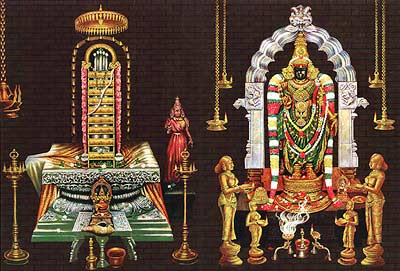
Shri Kalahasteeswara and Gnanaprasunambika
 This temple is considered as the Kailash of the South or Dakshin Kailash. Saivaite saints of ancient Tamil Nadu from the first century onwards have sung devotional songs about this Shiva temple. The chief architectural beauty of this temple lies in the fact that the entire shrine has been carved out of the side of a huge stone hill. All in all, this temple is one of the most impressive Siva temples in the whole of India.
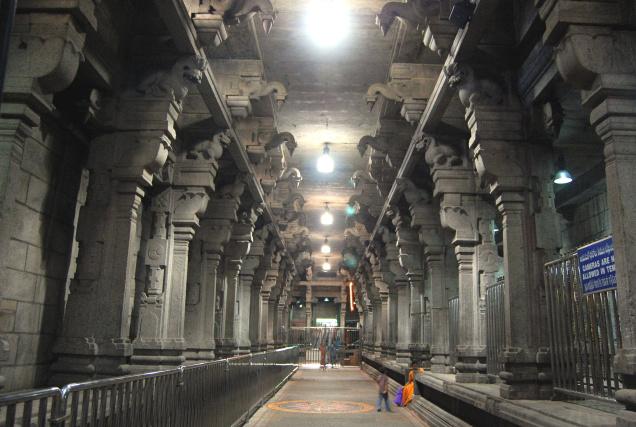
This temple is said to be the holy spot where a forest-dwelling tribal hunter by the name of Kannappa, one of the 63 Saivite Nayanars, came forward with supreme devotion to offer both his eyes to cover the holes from which the blood was flowing from the Siva linga. Lord Siva showered his Grace upon Kannappa by appearing before him in person and stopped him from pulling out his own eyes. Lord Shiva then granted Kannappa mukti or salvation.

Until about three decades ago, it was the practice of devotees to pass through the Rajagopuram after taking the bath in Swarnamukhi River. ALAS! On account of the callous neglect of the temple authorities, this great noble structure has collapsed.
The Andhra Pradesh Chief Minister K. Rosaiah has announced that the ‘Rajagopuram’ of the temple that has collapsed recently will be rebuilt with the assistance of the Archaeological Survey of India (ASI). He has said: “We will approach the Archaeological Survey of India to rebuild the Rajagopuram in a scientific mannerâ€. Expressing his grief over the collapse of the Rajagopuram at Sri Kalahasti, he has said: “An inquiry has already been ordered. It is a matter which has to be looked into. I don’t have any ready made answers.†He gave this reply when he was asked by the press as to whether the negligence by the State’s Endowments Department had led to the collapse of the Rajagopuram.
The Andhra Pradesh Government has formed a Committee of Experts to probe the reasons for the collapse of the ancient Rajagopuram tower. As thousands of pilgrims from all parts of India come to this temple for worship every day, the Kalahasti Temple earns an annual revenue of nearly US $ 22.50 Million and yet the temple authorities have not taken necessary steps to maintain this ancient and sacred tower.
This ancient temple dedicated to Lord Shiva is one of the Five Panchabhootha stalams (shrines or temples) celebrating Lord Shiva as the embodiment of the five primary elements, Wind being the element at the Sri Kalahasti Temple at Kalahasti; the other elements being Water at Thiruvanaikaval Temple near Tiruchirappalli, Fire at Annamalaiyar Temple at Thiruvannamalai, Earth at Ekambareswarar Temple at Kanchipuram and Space at the Chidambaram Temple.
As I have already explained in some detail above, the collapse of the ancient Rajagopuram Tower at Kalahasti has been caused by the criminal neglect of maintenance and upkeep of this temple by the Religious Endowments Department of Andhra Pradesh Government.
The Government in India after independence has shown nothing but indivisible contempt for India’s cultural heritage in the field of art, architecture, painting and sculpture. The Archaeological Survey of India(ASI) during the last ten years has degenerated into what I call The Archaeological Scourge of India (ASI). I am giving below some striking examples to show the nature and extent of organized depredations carried out by the Archaeological Scourge of India (ASI) in the name of preservation and conservation of ancient monuments.
Starting from the latter half of 2007, the Archaeological Scourge of India (ASI) undertook the task of renovation and restoration of the famous World Heritage Brihadeeswara Temple built by the great Chola Emperor Rajaraja CholaI between 985 AD and 1009 AD in the10th-11th centuries. Rajaraja Chola I ruled from 985 AD to 1014 AD. I am presenting below a photograph of this temple under ‘restoration’ which in my view led to different kinds of intended and unintended destruction of different aspects of this beautiful temple.
BRIHADEESWARA TEMPLE UNDER ASI DESTRUCTION IN August 2008
WANTON DESTRUCTION OF PRECIOUS ARTEFACTS OF BRIHADEESWARA TEMPLE BY THE ASI
http://janajaati.blogspot.com/2008/08/imminent-danger-to-thanjavur-big-temple.html
In the name of conservation many valuble inscriptions, pillars, mandapam, shrines and specimens of invaluable original art have been destroyed beyond repair and rendered beyond recovery leading to irreparable loss to the great Hindu heritage. The temple was apparently built like a jig saw puzzle. Each stone was weighed and balanced precisely vis-a-vis the whole complex structure; selected strictly according to agamas and shilapasastra and assembled like a mammoth jig saw puzzle. One has to know high level geometry and complex trignometry, material sciences and ancient temple architecture to understand the underlying principles of architecture governing the construction of this complex temple.
It is a fact of history that the entire gopuram was covered by Rajaraja Chola I by Gold leaf coating known as Veli. When Malik Kafur, the general of Emperor Alauddin Khilji (1296-1316) invaded South India in 1312-13, he not only destroyed two tiers on the ardha mandapam of Brihadeeswara Temple at Thanjavur, but also vandalised many parts of the temple. This temple remained under disuse for centuries and was rebuilt by the later day kings in the 16th and 17th centuries. The British and French had used the huge ramparts of the temple as their garrison in the last quarter of the 18th century and the first decade of the 19th century.
Over the years from 1970 to 1994 I have visited this temple several times. I was shocked to see this temple in a state of siege by the ASI in 2008. In 2008 when the ASI dismantled many portions of the huge complex using the services of many untrained commercial contractors, who were totally unfamiliar and ignorant about the ancient methods of construction technology adopted by the Chola Emperor Rajaraja Chola I in the construction of this Temple. Consequently, while they were able to mindlessly dismantle many structures without any difficulty, yet they just did not know how to put them back together so that they could again become harmoniously beautiful parts of several patterns of the original whole as conceived by Rajaraja Chola I. This explains as to why there are piles and piles of wreckage and debris lying scattered all round the temple complex in the two photographs given above.
When I visited Thanjavur in August 2008, the Brihadeeswara Temple Complex it resembled a war torn zone as in Iraq or Afghanistan. The whole area around the temple had been reduced to piles of broken pillars and beams. This ancient temple, which withstood the test of time, and the ravages caused by many floods, rains and earthquakes for centuries, was getting destroyed every day by the Archaeological Scourge of India (ASI).
I am deliberately using the word Archaeological Scourge of India (ASI) because informal instructions seem to have been issued by Sonia Gandhi and her Catholic cohorts in the UPA Government II for the planned and deliberate destruction of India’s Hindu cultural heritage and total obliteration of the racial memories of the Hindus dating back to the days of the Vedas and the Upanishads.
I was very shocked to note the marks of granite cutters that had been used to remove the blocks of stone called “kumudappadai”, the exquisitely beautiful lotus motifs that adorn the outside walls of the huge temple. These lotus motifs have been destroyed forever by the ASI. The following photograph graphically depicts the nature and extent of the savage destruction of the lotus motifs wrought by the Archaeological Scourge of India (ASI) through the use of stone cutters.
Obliteration of the lotus motifs by the ASI
Rajarajeswaram, more popularly known as the Big Temple at Thanjavur in Tamil Nadu, India, was built a millennium ago by the Chola Emperor Rajaraja I. The Big Temple is the living monument testifying eloquently to the multi-faceted glory and grandeur of the Chola Empire. It is a treasure-house of art, architecture, sculpture, painting, music and dance and several other aspects of the mosaic and tapestry of culture of ancient Tamil Nadu. The UNESCO has declared it as a World Heritage monument. It is completely under the control of the Archaeological Scourge of India (ASI).
             Â
What the Muslim Jihadi Malik Kafur could not achieve in the field of destruction in the 14th century, the Archaeological Scourge of India (ASI) has been able to achieve in a record time! IF THIS IS THE FATE OF ONE OF THE MOST ANCIENT AND BEAUTIFUL MONUMENTS IN INDIA WHICH HAS BEEN DECLARED AS A WORLD HERITAGE SITE BY UNESCO, THEN ONE CAN IMAGINE WHAT WILL BE THE FATE OF THOUSANDS OF MONUMENTS UNDER THE CONTROL OF THE ASI IN DIFFERENT PARTS OF INDIA!
During the last few years systematic vandalism has been let loose by the ASI within the sacred premises of this great shrine in the name of conservation. Millennium- old inscriptions on the temple walls, irreplaceable sources of authentic information relating to the Chola Period, are getting shattered into smithereens. Portions of the Northern circumambulatory mandapam (the circular hall), the upapeetam and the athishtanam of the Maha Mantapam (great hall or pavilion) as also the inner part of the Sri Vimana are being systematically destroyed in the name of restoration.
Â
The circumambulatory mandapam was built by the Chola Emperor Rajaraja Chola I’s General known as Krishnan Raman alias Mummudi Chola Brahamaraya. The inscriptions on the walls of this Big Temple bear eloquent testimony to the oral orders issued by the Great Emperor. A good many inscriptions were etched on the pillars, walls and basement of this temple. Among these structures, only one pillar was slightly damaged during the invasion of the French and the British armies in the 18th century. However, fortunately, the later Maharatta Rulers, with great care
and devotion, restored the pillar. Despite the ravages of time, the other pillars and also the roof-area of the Mandapam remained almost intact till the direct intervention of the ASI in 2007-2008. Alas, the pillars carrying these precious inscriptions, the cross-beams of the roof and also the ceiling stones have been broken to bits and thrown away by the ASI in the name of conservation and restoration!
The ancient and beautiful mural paintings on the temple walls of Tamil Nadu are getting either effaced or defaced by the callous and clumsy approach of either the concerned temple authorities or the Archaeological Scourge of India (ASI) or the State Departments of Archaeology or the State Departments of Hindu Religious and Charitable Endowments (HR&CE). I am giving below some instances of the ongoing process of destruction and vandalism of the ancient Hindu cultural heritage in this part of India.
In the first instance I would like to refer to the defacement of mural paintings in the Mannar Kovil Temple at Ambasudram, Tirunelveli District. This is considered to be one of the most important Temples in that district with its cultural and religious traditions dating back to earlier than 11th Century AD. The Mannarkovil Temple was built by Chera King Rajasimha in the 11th century A.D. for the Chola Emperor Rajendra (Ruler from 1012 AD to 1044 AD). It has an independent sub-shrine, belonging to the 13th century, devoted to the Vaishnavite saint Kulasekara Alwar, who spent his last days in Mannarkovil. It has inscriptions of the Chola and the later Pandya kings. It has three sanctum sanctorums.

Mannar Kovil Temple in Tirunelveli District in Tamil Nadu State
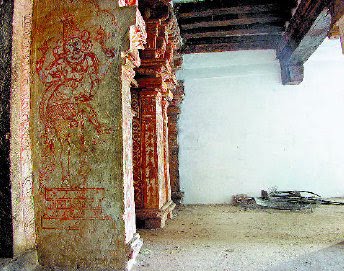
Effacement of the Murals in the name of Conservation
The above photograph depicts the vanishing legacy of mural paintings at the Mannarkovil Temple. We can see some surviving mural paintings juxtaposed with the whitewashed wall on the right where a ceiling-high painting of Lord Narasimha once existed. Shown below is a photograph of the since-effaced Narasimha painting, taken three years ago.

According to K.T. Gandhirajan, a specialist in art history, wonderful murals in the temples at Mannarkovil, Tirupudaimarudur, Idaikal and Kalakkadu, in Tirunelveli District have the rare characteristics of “the confluence of Tamil Nadu and Kerala schools of painting.†It is not therefore surprising that in all these temples what is special is that all of them have always had paintings on both walls and wood. Regardless of the surface, these murals have been destroyed by whitewashing.
During the last sixty-three years after our independence, thousands of mural masterpieces have been whitewashed out of existence for ever at the following temples:
a. Meenakshi temple in Madurai City.
b. Arunachaleswarar temple at Tiruvannamalai.
c. Vishnu temple at Tiruvellarai near Tiruchirappalli.
d. Siva temple at Patteeswaram near Kumbakonam.
e. Siva temple at Tiruppulivanam near Kancheepuram.
f. Siva temple at Vedaranyam.
g. Lakshmi Narasimhar temple at Sevilimedu near Kancheepuram
h. Sanjeeva Rayar temple at Iyengarkulam near Kancheepuram
All the above temples are administered by the Hindu Religious and Charitable Endowments Department of the Government of Tamil Nadu. Many mural paintings belonging to the period from 1600 AD to 1800 AD have been wiped out of existence in the name of renovation by the Department of Hindu Religious and Charitable Endowments (HR&CE) in Tamil Nadu!!!
I have given just two examples of effaced mural paintings above. The fact of the matter is thousands of mural paintings in ancient Temples have been whitewashed out of existence in all the States of South India — Tamil Nadu, Andhra Pradesh, Karnataka and Kerala.
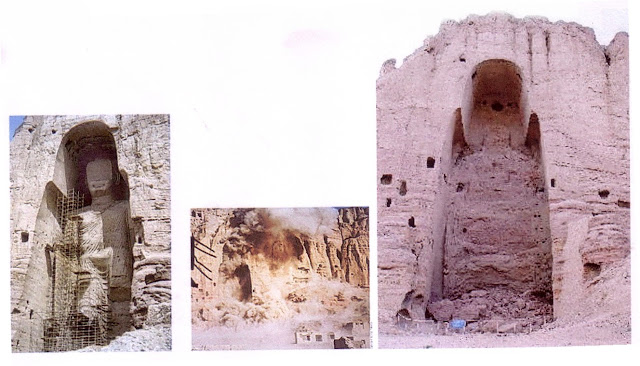
The Original Bamiyan statue The Taliban Destruction in progress The Taliban Decimation completed
In 2001, the Talibans in Afghanistan gave a death sentence to the ancient gigantic Buddha relics of Bamiyan in Afghanistan in these words: ‘All we are breaking are stones. These infidel statues are insulting to Islam and should be destroyed so that the infidels could never worship them again. These shrines of infidels should be destroyed forthwith and torn down’. Thus these Buddhist relics which had withstood the onslaught of centuries and ravages of nature for more than 2000 years were destroyed forever by the Talibans in just one day. The then UNITED NATIONS SPECIAL ENVOY, Pierre LaFrance, in Kandahar pleaded for the continued existence of these exquisitely carved, beautiful and gigantic Buddhist statues of Bamiyan. The Taliban rulers treated this request with utmost contempt and unconcealed hatred by ordering the destruction of those gigantic Buddhist statues forever. The Department of Hindu Religious and Charitable Endowments (HR&CE) is behaving no differently from the savage TALIBANS in Afghanistan.
Â
We don’t have to go to Kabul or Karachi or Islamabad to see the State-sponsored destruction of non-Muslim heritage structures or objects or places of worship. What happened at Bamiyan in Afghanistan is happening in the Indian State of Tamil Nadu today. Cultural and religious Hindu relics are getting destroyed everyday as part of high State Policy. Some months ago, human hands have brought down the massive and beautiful mandapa (granite stone pavilion) situated in the historically famous Varadharaja Perumal Temple at Kancheepuram in Tamil Nadu, which has with stood the onslaught of five centuries. This ancient temple was built by the Cholas in 1053 and it is one of the 108 divyadesams or the holy abodes of Lord Vishnu. It is located in that part of Kanchipuram which is traditionally known as Vishnu Kanchi. Vishnu Kanchi has been the home for a lot of famous Vishnu temples, including the Varadharaja Perumal Temple. The great Vaishnavite saint Ramanujacharya is believed to have resided in this temple.
Â
Â
Varadharaja Perumal Temple at Kancheepuram
Sri Varadharaja Perumal Temple is a huge temple spread over a 23 acre complex. The earliest reference to this temple is in a Pasuram of Boothathazhwar, a Vaishnavite Saint, dating back to 600 AD. The temple began to gain prominence in the 11th century, during the period of the Chola Dynasty. Kulothunga Chola-I encased the rock and built a structural temple around the standing Vishnu in A.D. 1100. Later by stages, spread over a few centuries, this temple expanded with the construction of several shrines, prakaras (corridors) and gopurams (towers). According to Dr. Nagaswamy, Vijayanagar Emperor Krishnadevaraya (Ruled from 1509-1530) built the present sanctum sanctorum of Sri Varadharaja Perumal Temple, the Vimana above it and covered it with gold sheet around A.D. 1525. Krishna-Devaraya’s successor Achyuthadevaraya (Ruled from 1529-1542) built the Kalyana Mandapa on the left side beyond the western entrance to the temple in 1535 AD. This Mandapa is known for its several hundred pillars with intricate carvings of horse-riders, dancers, musicians, and Gods and Goddesses. It is known as Nootru-Kaal Mandapam.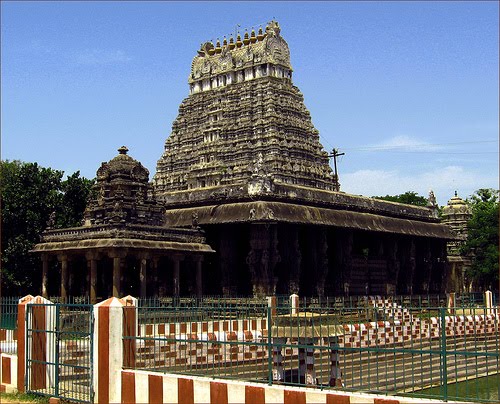 Â
Â
Nootru Kaal Mandapam
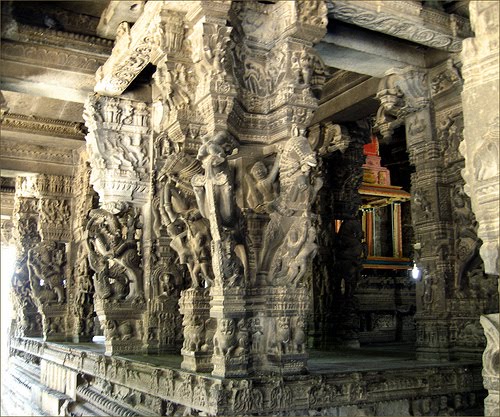
Exquisite sculptures in Nootru Kaal Mandapam at Sri Varadharaja Perumal Temple, Kanchipuram
Nootru Kaal Mandapam built by Vijayanagar Emperor Achyuthadevaraya in Varadharaja Perumal Temple (God only knows when this will receive the sentence of sudden death!)
Apart from constructing the exquisitely beautiful Nootru Kaal Mandapam, Vijayanagar Emperor Achyutha Devaraya also built another Mandapa with a few hundred pillars, all hewn out of granite. This was used for conducting temple festivals in the past. Later, it was used as a Goshala, or cow shed. IT IS THIS MANDAPA THAT HAS BEEN PULLED DOWN NOW UNDER THE PRETEXT OF ‘RENOVATION’. This Mandapa was not touched in any manner even during the days of colonial English Rule. I am presenting below two pictures relating to the destruction of this Mandapa in Varadaraja Perumal Temple at Kancheepuram.
 
The Mandapa of the Sri Varadaraja Perumal Temple being demolished.
When this Mandapam at Sri Varadaraja Perumal Temple in Kancheepuram was getting destroyed, Dr. R.Nagaswamy, former Director of the Tamil Nadu Archaeology Department rightly said: ‘What is happening now is total destruction. They are not dismantling it. They are smashing it with a crane’. I fully endorse his view that it is ‘a thoughtless act of destruction and renovation. The Mandapa could have been cleaned easily, conserved and preserved. The entire Mandapa is in good condition…. The walls are in perfect alignment. It has survived for 500 years without tilting or developing cracks. Except that it has not been cleaned, it is in good shape’.
The Sri Varadharaja Perumal temple was earlier subjected to a bout of cultural vandalism (Dravidian Talibanism!) when the murals of Lord Vishnu, Goddess Lakshmi and other Gods in the Hindu pantheon were deliberately whitewashed over by the Department of Hindu Religious and Charitable Endowments (HR&CE). The surviving paintings have faded or peeled away. They have not been preserved. Thus, the atheist communist moles in the state government are working in a planned manner for the total obliteration and extinction of the Tamilian Hindu temple heritage and ethos.
The main aim of such deliberate destruction of the Hindu Temple murals seems to be that the white-washed empty temple walls after the planned destruction of the murals can be used to paint Christian motifs like the Last Supper, Nativity, Jesus and Mary on the Temple Walls.
Â
This sad story of State-sponsored destruction of the ancient Hindu temple heritage in Tamil Nadu will be incomplete if I don’t make a reference to the destruction of the 975-year-old beautiful Chola period paintings and sculptures at the 1200-year-old Siva temple of the Pallava period at Tiruppulivanam village in Kanchipuram district, Tamil Nadu. Shri T.S Subramanian reported on this destruction done by the HR&CE Department of the Government of Tamil Nadu in Saturday, Nov 08, 2008. It is a matter of ironical shame that at a seminar organized on the very same temple premises on August 27, 2007, archaeologists, epigraphists and artists had decided on measures to preserve the paintings and inscriptions in the temple.
Two 16-pillared mantapas are among the temple’s treasures that have been destroyed. One of the mantapas, which was commonly called ‘madapalli’ or kitchen, had Tamil inscriptions dating back to Kulotunga Chola III (1215 A.D.), the Telugu Chola Vijayakanda Gopaladeva, Rajanarayana Sambuvaraya and others. The other mantapa, called Alankara Mantapa, belonged to the 16th century Vijayanagara period. 
EFFACED LEGACY: (Clockwise from top left): The prakara wall of the Vyagrapurisvara temple at Tiruppulivanam sans its frescoes that were sandblasted recently; one of the Chola frescoes as it existed, in a file image provided by the Archaeological Survey of India; pillars with sculptures at the temple, also sandblasted and disfigured.
This destruction has taken place during “renovation†that the Hindu Religious and Charitable Endowments (HR and CE) Department officials are undertaking. As part of this exercise, they plan to pull down a 100-pillared mantapa just outside the temple and “rebuild it.â€
The Vyagrapurisvara Temple at Tiruppulivanam, near Uttraramerur, 95 km from Chennai, was one of the three temples in Tamil Nadu where Chola paintings existed. The others where they still exist are the Brihadeesvara temple in Thanjavur and the Vijayalaya Cholisvara temple near Pudukottai. (We don’t know when the Tamil Nadu Government sponsored anti-Hindu Dravidan Vandals will get to them)
When Shri T.S Subramanian and a photographer visited the temple on November 2, 2008 an earthmover was piling up the dismembered granite slabs of the Alankara Mantapa. The officials of the HR&CE Department of the Government of Tamil Nadu are behaving like the Talibans of Afghanistan.
In the main temple itself, sandblasting had been done on the southern, northern and western walls of the prakara, on the sculptures on pillars and on the ancient Tamil inscriptions — in violation of a State government directive against sandblasting for renovating temples. The inscriptions on the outer wall of the sanctum sanctorum and the sculptures stand disfigured.
The temple existed during the reign of the Pallava king Nandivarman II in the 8th century A.D. The Rashtrakuta king Krishna III, the Chola kings Parantaka I, Rajendra I and Kulotunga I, the Sambuvaraya chieftain Rajanarayana and the Vijayanagara rulers added structures to it.
What stood out were the Chola frescoes, painted perhaps during the rule of Rajendra I, on the northern prakara wall. Dr. A. Padmavathy, retired Senior Epigraphist, Tamil Nadu Archaeology Department, said the paintings were of Siva as Tripurantaka (riding a chariot and armed with a bow and arrows to kill the demons of the three worlds) and Nataraja, and of Dakshinamurti, Narasimha, and Vishnu in “ananthasayana†posture. There were murals of Raja Raja Chola’s teacher Karuvur Thevar and of princes, princesses, dancing girls, ponds with lily and lotus flowers and wild animals. THESE FRESCOES DO NOT EXIST TODAY. THE MANTAPAS, ONE WITH ANCIENT INSCRIPTIONS, ARE GONE.
When contacted, the Temple’s Executive Officer, S. Senthil Kumar, of the Talibani HR & CE Department of the Government of Tamil Nadu, claimed that “no paintings ever existed in the temple†and “no structure called Alankara Mantapa ever existed†and that “no sandblasting was ever done†and that only “water-wash and air-wash†were done. He added that the ‘madapalli’ mantapa was demolished long before he took charge of the temple eight months ago. However, informed sources asserted that the frescoes were sandblasted four months ago, the ‘madapalli’ mantapa demolished about six months ago and the Alankara Mantapa brought down a year ago.
In the last couple of decades, many valuable inscriptions in temples and other ancient monuments have been lost. At a time when preservation of historic monuments has become a hot topic, an expert voice is stressing the imperative public need to adopt a professional approach towards the task of preservation of ancient monuments. Some time back, Dr R. Nagaswamy, former director of the Archaeological Department, Government of Tamil Nadu explained very eloquently as to how invaluable and unique ancient monuments have been defaced in Tamil Nadu on account of the careless attitude of the authorities. Dr Nagaswamy had warn
Welcome to Haindava Keralam! Register for Free or Login as a privileged HK member to enjoy auto-approval of your comments and to receive periodic updates.
Latest Articles from Bharath Focus
- Narendra Modi: The Architect of India’s Momentous Transformation
- Republic Day Tableaux & Regional Pride
- Tarun Vijay meets Governor Arif Khan on Adi Sankara birthplace
- SC-ST പോസ്റ്റ് മെട്രിക് സ്കോളർഷിപ്പിൽ 5 ഇരട്ടി വർദ്ധനവ്
- Treading the Middle-Path on Temple Management
- Taming the dragon-Part-3
- Taming the dragon- Part 2
- India- China trade wars on the cards? Well researched blog on Indian govt.’s proposed plan to tax 371 Chinese goods
- Before removing the idols, I should be removed; Two Kerala faces we should never forget
- The Unseen Unheard Victims of Article 35(A)


Responses